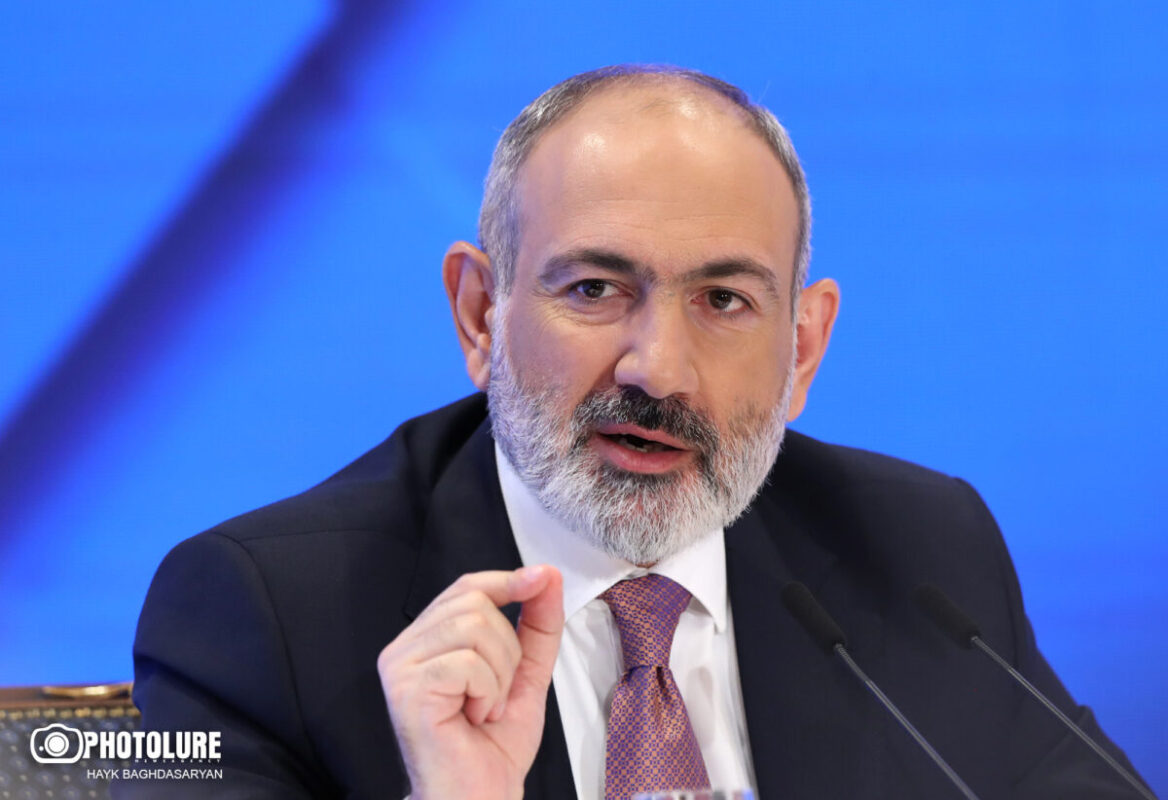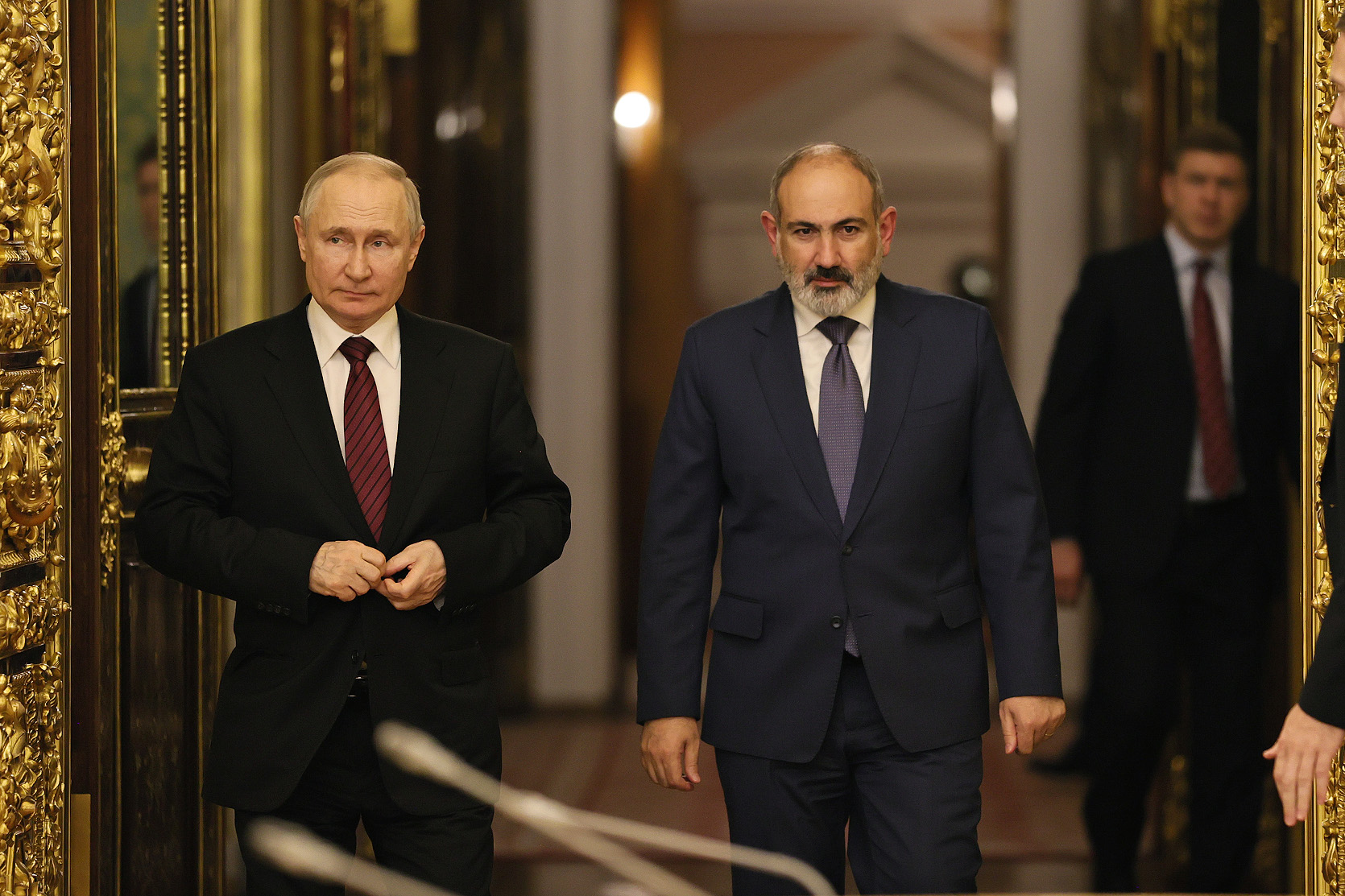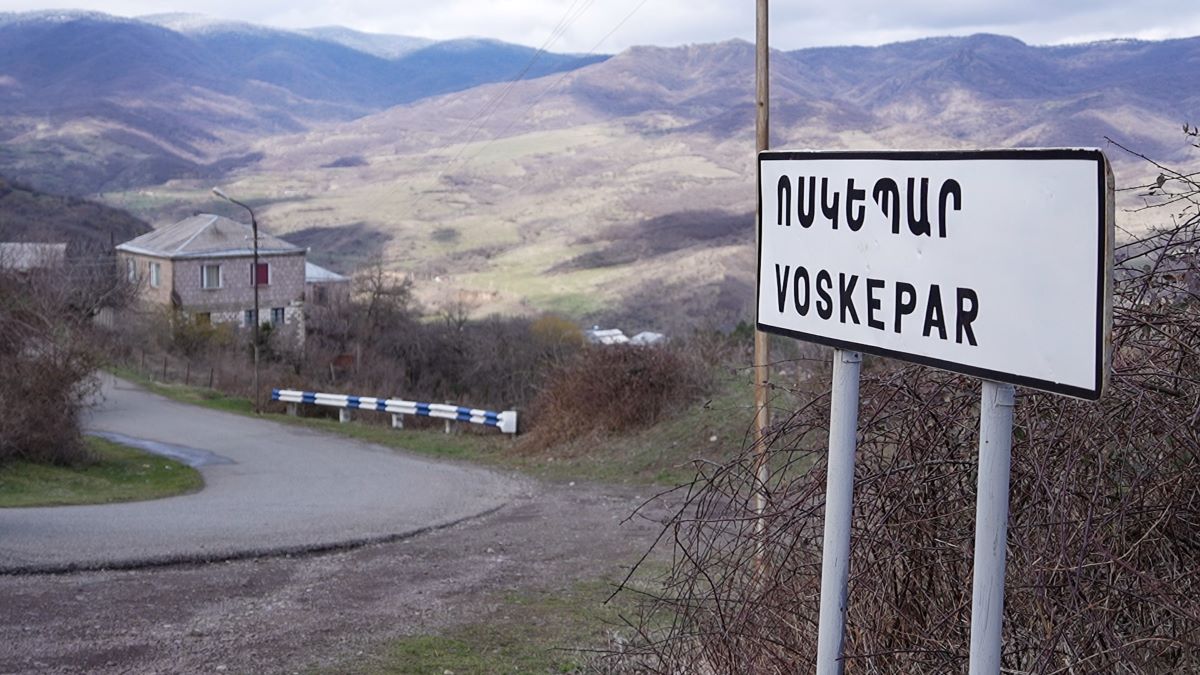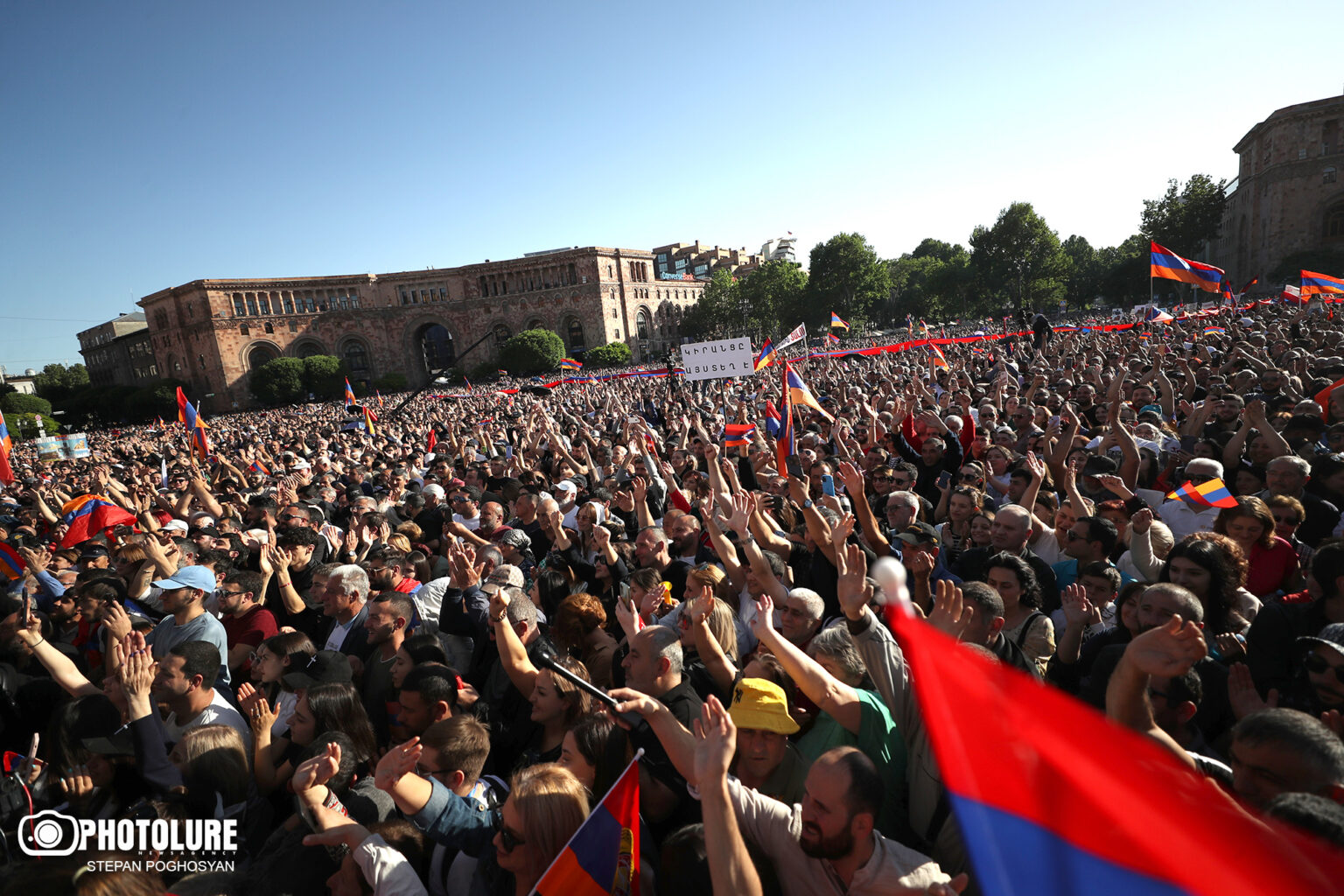
Protest in Yerevan against border demarcation with Azerbaijan
On May 9th, participants of the “Tavush for the Homeland” movement, who began their march from the northern border of Armenia in protest against the demarcation of the border with Azerbaijan, reached Yerevan.
A rally was announced in advance at the main square of Yerevan, and thousands of people gathered here at the appointed hour. However, during the rally, another demand was voiced.
The movement demanded the resignation of Prime Minister Nikol Pashinyan. He was given an hour to resign. However, no reaction was received from the government building, located on the same square where the rally was held.
Leading the movement, Archbishop Bagrat Galstyan of the Tavush Diocese, stated that the struggle would continue. On the morning of May 10th, he called on all supporters of the movement to start peaceful acts of disobedience in Yerevan and throughout the country.
After consulting with representatives of two opposition parliamentary factions that joined the movement, Bagrat Galstyan informed the gathered crowd that deputies would initiate the procedure for the prime minister’s resignation in parliament by declaring a vote of no confidence.
It was an unexpected turn, as previously he had stated that the movement did not intend to demand the government’s resignation.
He declared that the protest’s goal was to halt the unilateral demarcation process, which implied concessions from the Armenian side. As the archbishop is a highly respected clergyman, his statements did not raise doubts.
Regarding the demarcation and delineation process, during the rally, Bagrat Galstyan declared it illegal and unconstitutional. He pleased the attendees by announcing that the movement had already achieved certain results. Demarcation has already been halted, “the last three border posts on the border with Azerbaijan have not been installed.” According to him, this is the result of the people’s struggle.
Armenian political analysts have labeled this movement as a “Russian initiative.” They believe that the Kremlin is attempting to exert pressure on the Armenian authorities through its supporters in Armenia, the so-called “fifth column,” in order to prevent further rapprochement with the West.
Local analysts consider the cessation of the demarcation and delineation process dangerous for Armenia, as it could lead to war. They explain that this would also be unwise. It would mean that Armenia handed over four villages to Azerbaijan in the Tavush region, where the process is almost complete, but then refused to complete the process, that is, to reclaim its territories from Azerbaijan.
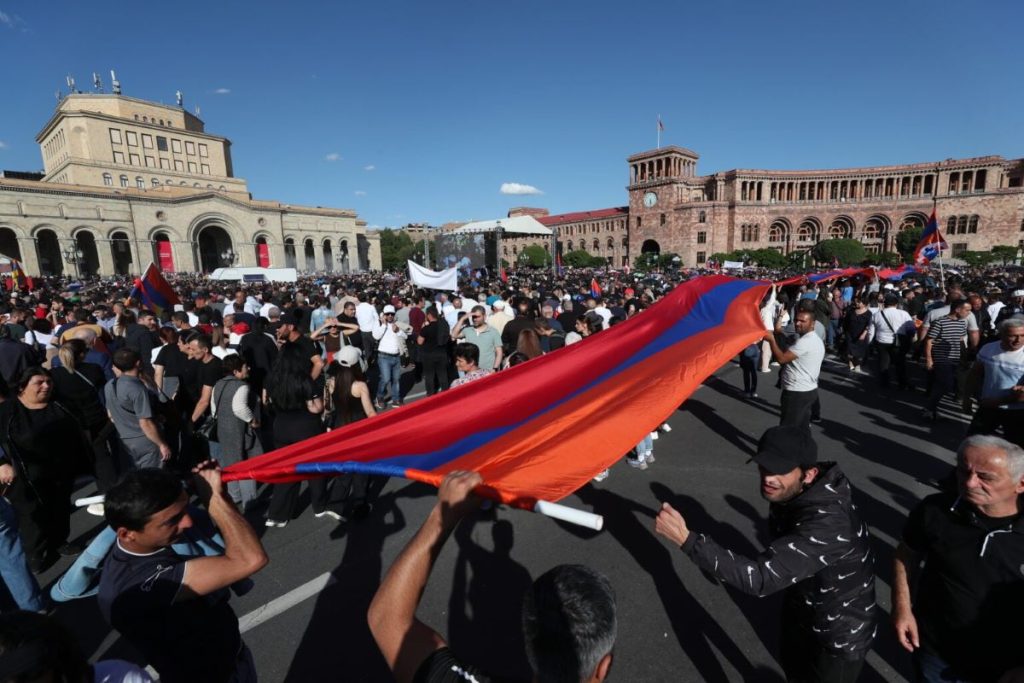
“We are not against peace and border demarcation”
The rally began two hours late, but the gathered crowd patiently waited for the marchers to arrive. Initially, they chanted “Armenian, Armenia, Homeland, and God,” words from a song that has become the movement’s anthem. Then they sang the Armenian national anthem and prayed together with Archbishop Bagrat Galstanyan, who leads the movement.
Galstanyan stated that he wore a white robe because this color symbolizes “reconciliation, peace, and victory.”
“We are not against peace, demarcation, and delimitation. But we are against making unilateral concessions, bowing down. This is unacceptable to us,” he said.
Galstanyan said, that Prime Minister Nikol Pashinyan “lied, deceived, and misled the residents of Tavush, and then scared and threatened them with war.” And now they have come to the square to “demand accountability for these threats and to stop the unilateral and illegal process,” which is being conducted under the threat of force from Azerbaijan.
“There is no precedent in the world for territories to be relinquished unilaterally under the threat of the use of force and without assurances that there will be no war,” he emphasized.
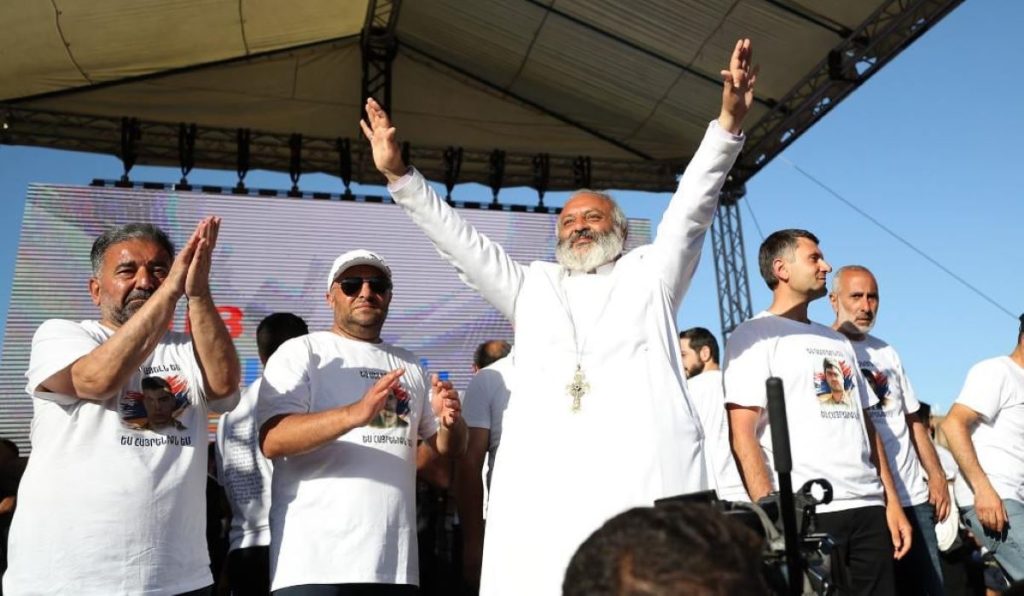 Archbishop Bagrat Galstanyan welcomes the participants of the rally
Archbishop Bagrat Galstanyan welcomes the participants of the rallyBut ultimately, he articulated and presented on behalf of the movement only one demand – the resignation of the Prime Minister.
Increased police presence at the square
Prior to the start of the rally, a large number of police officers were deployed to the capital’s center. Police Chief Aram Oganesyan told journalists that this measure was taken to ensure public order.
 Since the “velvet revolution” of 2018, there hasn’t been such a large rally in Yerevan
Since the “velvet revolution” of 2018, there hasn’t been such a large rally in YerevanBefore the rally, the Armenian National Security Service and the police urged participants of the movement to “abide by the law.” Statements from both agencies emphasized that any unlawful actions endangering the constitutional order “will be neutralized using all legal means available.”
All about the movement
The “Tavush for the Homeland” movement emerged amidst protests that began on April 19, immediately after the announcement of the start of the demarcation process of the border in this region. Movement participants stated that their goal is to halt the demarcation process both in the Tavush region and in other regions of Armenia.
They argue that the Armenian authorities are making unilateral concessions, resulting in security problems for residents of border settlements. In response, the ruling team declared that those behind the movement, demanding an end to border demarcation, have political aims, notably a change in government. They allege that the movement aims to provoke war.
The protest movement kicked off on May 4 from the village of Kirants in the Tavush region. Currently, Archbishop Bagrat Galstanyan leads the movement. However, the movement has officially gained support from former authorities in Armenia.
Alongside the head of the Tavush diocese, members of the “Ayastan” faction, a political force founded by former President Robert Kocharyan, are regularly present. The rally also saw participation from deputies of the opposition faction “I Have Honor,” representatives of the “National Democratic Pole,” the “Enlightened Armenia” party, and other lesser-known opposition alliances.
Parents of soldiers who died during the 2020 Karabakh war have also joined the protest movement. They attended the rally wearing white t-shirts bearing portraits of their deceased sons.
Comments
Political analyst Ovsep Khurshudyan labels the movement against border demarcation as a “Russian initiative.”
He believes that Moscow is attempting to exert pressure on the Armenian government in this manner. He does not see it as a coincidence that the march of the “Tavush for the Homeland” movement headed towards Yerevan on the eve of Pashinyan’s visit to Russia.
“On April 5, a serious foundation was laid for Armenia’s European integration [referring to the Armenian Prime Minister’s meeting with the US Secretary of State and the President of the European Commission in Brussels]. And now Putin needs assurances that Nikol Pashinyan will not let the West into Armenia. This is an attempt to pressure the Armenian government through the fifth column,” he believes.
Khurshudyan thinks, Moscow is ready to organize any provocation, but both the Armenian armed forces and law enforcement agencies are aware of the Russian threat.
“From various regions of Russia, ‘tons’ of criminal elements, mostly of Armenian nationality, have been dispatched. It’s unclear how they intend to use them. Against the backdrop of provocations and disorder they could incite here, for example, they might deploy troops from the Russian military bloc CSTO in Yerevan,” the analyst speculates.
Political scientist Stepan Grigoryan has reservations and remarks regarding the ongoing process of border delimitation and demarcation with Azerbaijan.
In particular, he is concerned about the absence of guarantor institutions. However, he believes that halting the process at this stage would be incorrect. He urges participants of the “Tavush for the Homeland” movement not to promote such theses in their political struggle.
“If Yerevan decides to halt delimitation-demarcation now, it would be a “gift” for Baku,” Stepan Grigoryan said.
“This would mean giving away four villages to Azerbaijan [on the northern border, regarding which decisions have already been made by the delimitation commissions of both countries] without getting anything in return. Azerbaijan will be pleased because now it’s expected to return our territories to us. It must return territories around Jermuk, around Lake Sev Lich [referring to territories where the Azerbaijani Armed Forces advanced in 2021 and 2022].“
He views it positively that the Armenian-Azerbaijani agreements are based on the Alma-Ata Declaration of 1991, and the delimitation and demarcation process is conducted according to the latest, i.e., the last, maps of the USSR.
Grigoryan assured that he knows which year’s maps the delimitation commissions are guided by, although the Armenian authorities do not publicly disclose this information. According to him, as a result of demarcation based on these maps, the Goris-Kapan road in the south of the country, which is currently under Azerbaijani control, should return to Armenia.
He emphasizes that the decision to halt the border clarification process will not be understood by the international community, which has already welcomed the start of work.
Speaking about the participants of the movement, he noted that behind the ordinary people dissatisfied with the authorities, the “ears of former authorities” are visible.
Grigoryan suggests focusing now on another issue: developing and approving a procedure for the joint work of the delimitation commissions of the two countries, which will ensure the continuity of the process on other border directions.

